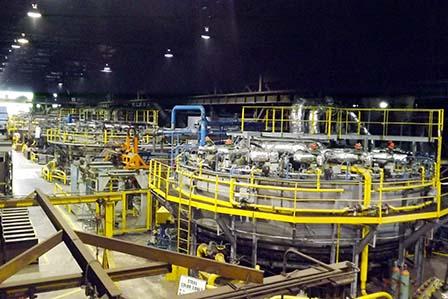Explosives Manufacturing Effluent Guidelines
 EPA promulgated the Explosives Manufacturing Effluent Guidelines (40 CFR Part 457) in 1976. The regulation only applies to direct dischargers
EPA promulgated the Explosives Manufacturing Effluent Guidelines (40 CFR Part 457) in 1976. The regulation only applies to direct dischargers![]() direct dischargerA point source that discharges pollutants to waters of the United States, such as streams, lakes, or oceans.. The Effluent Guidelines are incorporated into NPDES permits.
direct dischargerA point source that discharges pollutants to waters of the United States, such as streams, lakes, or oceans.. The Effluent Guidelines are incorporated into NPDES permits.
- What is the Explosives Manufacturing Industry?
- Pollutants and Subcategories
- Rulemaking History
- Additional Information
What is the Explosives Manufacturing Industry?
Explosives manufacturing can be divided into two broad areas: military and commercial. Military plants produce strictly for the military and commercial plants produce for both military and non-military clients. Plants can differ in size, product and type of operation. Ammonium nitrate-based explosives, dynamite, and nitroglycerin are generally considered commercial explosives, while TNT, HMX, and RDX are generally considered military explosives.
Sources of wastewater pollutants include aqueous wastes from reactors, filtration systems, decanting systems, distillation vacuum exhaust scrubbers, caustic scrubbers, process equipment cleanouts, area washdowns, formulation equipment cleanup and spill washdowns.
Explosives Manufacturing is included within NAICS group 325920. The NAICS listing is provided as a guide and does not define the coverage of the Explosives Manufacturing category. For precise definitions of coverage, see the applicability sections in 40 CFR Part 457.
Pollutants and Subcategories
Regulated Pollutants
-
COD
-
BOD5
-
TSS
-
pH (abnormally high or low)
-
Oil and grease
Regulation Subcategories
- Manufacture of Explosives
- Explosives Load, Assemble, and Pack Plants (plants which blend explosives and market a final product, and plants that fill shells and blasting caps)
Excluded Processes
-
Inorganic Chemicals Manufacturing (40 CFR Part 415)
Rulemaking History
1976 Initial Rulemaking
- Documents, including:
- Interim Final Rule (March 9, 1976)
- Development Document (March 1976)
Industry description, wastewater characterization, treatment technologies, regulatory compliance cost estimates and pollutant loadings for the final rule
Additional Information
For additional information regarding Explosives Manufacturing Effluent Guidelines, please contact Anthony Tripp (tripp.anthony@epa.gov) or 202-566-1419.
